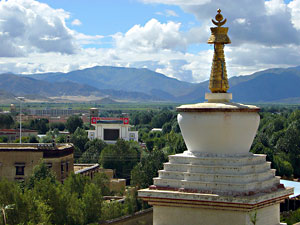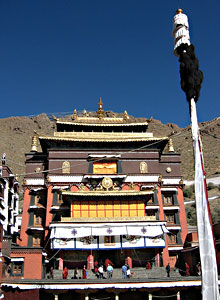|
|
Shigatse, Tibet |
|
Information about Shigatse
Shigatse also known as Xigatse is the second largest
city in Tibet. Situated at the junction of the Yarlong
Tsangpo (Brahmaputra) and Nyangchu River, Shigatse
literally means "fertile land". shigatse is located
around 300 km west of Lhasa, at an altitude of 3800
meters above sea level. This 600 year old city was
earlier the capital of Tsang province and now is the
capital of Shigatse prefecture. It is an important stop
between Lhasa and west Tibet for pilgrims and tourists.
The city has hit the top in the count of tourist and
adventurers that come here to witness the |
 |
|
|
might and
grandeur of the highest peak in the world, Mt. Everest.
Shigatse has a population of over 80,000, of which 97% are
Tibetan. It holds famous Tashilhunpo Monastery which is the
traditional seat of the Panchen Lama, who is one of the two
prestigious spiritual leaders in Tibet.
Climate in Shigatse
Shigatse shows different climatic conditions in summer and
winter. The summer is usually mild and wet, and brings most of
the annual rainfall, but quite pleasant. Winter is cold, dry
and windy. The best time to travel to Shigatse is from May to
July, when the temperature is neither too high nor too low.
Shopping in Shigatse
Shigatse, over the time has undergone several face lifts and
now is one of the most advanced cities in Tibet. The place is
a treat for people who like to shop till they drop. Shigatse
is right place to shop original Tibetan handicraft items. The
markets in the area absolute brims with varieties of unique
items. The specialty of this city are the handicrafts. The
national handicraft industry produces items completely unique
in style and quality. You can also look for the locally made
carpets, traditional wears, Tibetan knives, gold and silver
ware, silk covers for cushions, traditional bracelets, unique
boots that become a kind of necessity during Tibet travel as
these are stitched suited to Tibetan terrain.
Trekking in Shigatse
Shigatse has become the favorite spot of adventurers because
of Mt. Everest that stands tall on this land. The routes
around Mt. Everest are the most challenging in entire Tibet,
probably in entire world. Darchen to Mt. Everest is the most
favored trek route of all.
Tourist Attractions in Shigatse
Shigatse has a lot to offer to the tourists with its high snow
capped peaks, wonderful monasteries and colorful markets that
are filled with amazing Tibetan stuff. The city is dotted with
some of the most sublime and important monasteries like Sakya
Monastery and Tashilhunpo Monastery apart from the grand Mt.
Everest which is the highest peak in the world. The most
popular site of the city, Tashilhunpo Monastery is the biggest
monastery of Gelugpa or yellow hat sect in Tibet. Apart from
shopping and adventure, you can also enjoy number of live
performances of Tibetan opera, which is a specialty of
Shigatse city. |
|
|
|
Tashilhunpo Monastery
Tashilhunpo Monastery is located at the west part of the
Shigatse city and about 250 km away from the capital of
Tibet Lhasa. Situated on the foot of Drolmari or Tara’s
mountain, it is one of the huge Monasteries of Gelugpa
(or Yellow Hat Sect) in China and the biggest Tibetan
Gelugpa Buddhism monastery in back Tibet area. Standing
on a whooping area of around 300,000 sq. m it is also
called the Heap of Glory. It is known as a seat of the
Panchen Lama who is considered to be the second most
important religious leader of Tibet. Founded by the
first Dalai Lama in the year 1447 the monastery
significantly expanded by the fourth and successive
Panchen Lamas. The Monastery covers an area of nearly
300,000 square meters. The main structures found in the
Monastery are The Maitreya Chapel, The Panchen Lama's
Palace and The Kelsang Temple. Tashilhunpo is the seat
of the Panchen Lama since the Fourth Panchen Lama took
charge in the monastery, and there are now nearly 800
lamas. When seen from entrance the gran d building
|
 |
|
|
of monastery
enchants the visitor with its golden roofs and white walls.
The Thangka Wall built by the First Dalai Lama in 1468 is
outstanding with its nine floor high structure. The wall
displays the images of Buddha on the 14th, 15th and 16th of
May every year following the Tibetan Lunar Calendar. The west
side of the monastery holds Maitreya Chapel, which houses the
biggest statue of a sitting Maitreya Buddha. The statue stands
26.2 meters (86 ft) high and is adorned with gold, copper,
pearl, amber, coral, diamond and other precious stones. About
nine hundred artisans handcrafted this statue in nine years.
The Maitreya chapel has been divided into five floors. There
is wooden staircase in the chapel that is used to visit the
different floors of the chapel. One can more clearly see the
statue from the upper floors of the chapel. In the east of the
chapel lies the Stupa-tomb of the Tenth Panchen Lama. Built in
1993 and enclosed by 1,354 pounds (614 kg) gold, 868 precious
stones and 246,794 jewels, the Stupa-tomb is the most splendid
and expensive mausoleum in China since the 1950s. The Panchen
Lama's Palace built during the reign of the Six Panchen Lama
stands nearby the Stupa-tomb, but it is not opened for
visitors. To the east of the Panchen Lama's Palace lies the
first stupa-tomb of Tashilhunpo. This stupa-tomb belongs to
the Fourth Panchen Lama who is one of the most famous Lamas in
Tibetan history. He was also the teacher of the Fifth Dalai
Lama. Ornamented with gold and silver this magnificent stupa-tomb
was built in 1662.
In addition
to the majestic palace and gigantic statues, the Tashilhunpo
Monastery also treasures distinctive murals. These murals are
notified for their variety of shapes, brilliant colors and
fine painting and are considered to be another masterpiece of
Buddhist art. Monastery also houses some rare sutras, thangka,
china and glass services of the Ming and Qing Dynasties. Thus,
Tashilhunpo Monastery helps you to explore the history and
society of Tibet.
Mt. Everest
The highest and the most celebrated peak in the world, Mt.
Everest leaves no stone unturned in overpowering your senses.
The Everest, also called as Qomolangma in Tibet, has its tip
covered with snow throughout the year. This peak is virtually
worshiped by all mountaineers as climbing to the top of this
mountain is the biggest challenge and the ultimate goal in any
mountaineer's life. You as a tourist can also get the same
fun, ecstasy and feel the same rush of blood but in an easy
way, just stand on the foot of this prodigious part of earth.
It is advisable that you choose a time when the rains are away
to visit Mt. Everest, possibly in April to July.
Palkhor Monastery
The monastery is famous for it's unique architecture and the 'Bodhi
Stupa' or 'Kumbum'. Built in the year 1427, the monastery has
gained the position as the Lord of Tibetan Stupas. The Palkhor
monastery is a classical example of age old Tibetan
monasteries as it houses both, a temple and a Stupa. What you
would find most interesting can be the mural paintings on the
wall that depicts stories of Buddha. You will notice that the
painting style in this monastery is quite different from
paintings that one seen in other monasteries. Visit the
monastery on 15th of April according to Tibetan calendar Saka
Dawa festival is celebrated, the birthday of Sakyamuni. An
absolute gala, to say the least. The monastery is open from 9
in the morning till 4 in the evening.
More...
Sakya Monastery
Sakya Monastery is the first monastery of Sakyapa Sect. Like
other monasteries, this one is also famous for its uniqueness.
The monastery is more than 900 years old and has the
collection of few of the most valuable pieces of Tibetan
history. Most important of all are the handwritten sutras of
about 3000 in number. The main attraction of the monastery is
the central hall called Lakhang Chenmo Hall. The name of the
monastery means 'Grey Soil' because of its surroundings
heavily dominated by grey colour. The monastery is open from 9
AM to 12 noon and reopens at 2 PM till 6.30 PM.
How to Reach Shigatse
By Road
Shigatse is fairly developed city and well connected with all
major cities of Tibet by highways. Transportation in and out
of Xigatse hugely depends on road travel and buses are the
main mode of transportation on highways. Apart from privately
run buses, you can hire Taxis that are the most convenient way
of traveling inside the city. And since Shigatse is not a huge
area, one can also walk through the narrow lanes of the city,
though it is not advisable for people with health problems as
the city is at a high altitude. |
|